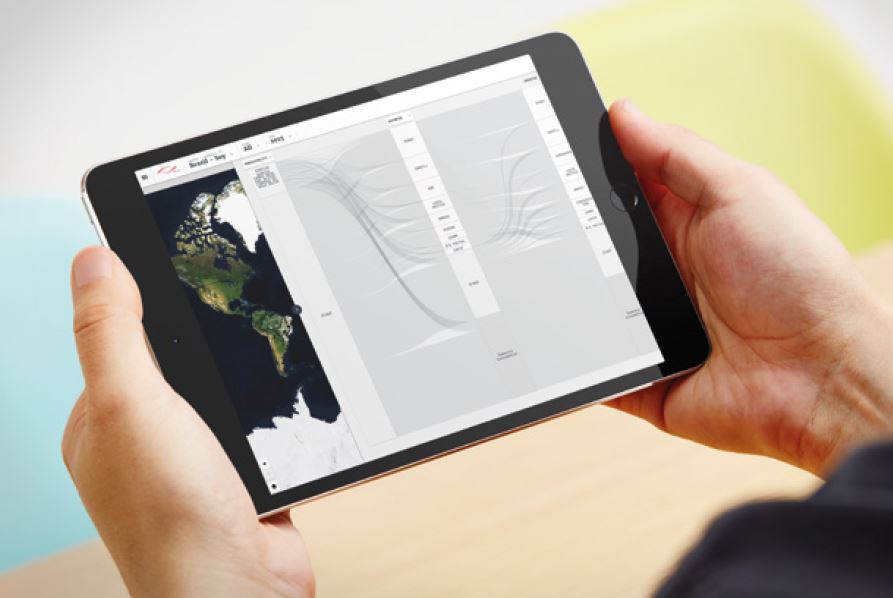This change story was originally published in our 2017 annual report.
One of the biggest drivers of deforestation in the world’s remaining tropical forests is agricultural expansion to meet the relentless demand for commodities such as soy, palm oil, coffee, cocoa and beef. As well as threatening biodiversity, this deforestation has negative impacts on the global climate and on local communities. After decades of inaction, many companies and governments are committing to eliminate deforestation from their supply chains. However, despite increasingly good intentions, the opacity (and complexity) of global trading networks have severely limited progress, and continue to mask unsustainable practices.
Trase enables users to understand the flows of so-called forest-risk commodities. It dynamically maps and visualises the movement of commodities from their point of production to the importers in consumer countries around the world. Through such “blanket” transparency, Trase reveals the movements of almost the entire internationally traded volume of the commodity and identifies the various actors (traders, exporters, importers, shippers) along the supply chain. Trase complements this mapping with other information to create a powerful decision-support tool for governments and companies.
“Trase can help catalyse improvements across the board: in production practices, procurement and investment policies and the governance of supply chains by both producer and consumer governments.”
—Javier Godar, Senior Research Fellow, SEI

Since its launch at the COP22 climate summit in late 2016, the initiative has radically changed perceptions of what is possible in supply chain governance. The Trase team has quickly positioned Trase at the heart of a number of critical processes led by companies, governments and civil society.
Trase is the lead research partner in the new Soy Buyers Coalition, for example. This initiative, led by the Consumer Goods Forum, brings together downstream soy users including major European retailers, animal feed producers, food companies and others to collaborate on addressing deforestation linked to their soy supply chains. Trase is helping the coalition members to identify deforestation-risk hotspots in Brazil – particularly those that are in their supply chains – with a view to taking joint action to reduce deforestation. In a sign of their confidence in Trase, the companies involved in the coalition are sharing sensitive commercial data with the initiative to help the process.
In another important partnership, Trase is helping the bank Santander to use the Trase.earth platform to guide lending decisions. The Trase team is supporting Santander analysts in identifying appropriate indicators and analytics in order to assess the deforestation-risk profiles and performance of potential loan customers.
What’s more, Trase is recognised as a critical source of data for assessing progress towards Goal 2 of the 2014 New York Declaration on Forests: eliminating deforestation from the production of agricultural commodities. The Trase team recently launched the Trase Yearbook, which provides systematic monitoring of changes in deforestation linked to international supply chains of forest risk commodities, helping to assess, for the first time, whether companies and countries are on track to meet zero-deforestation commitments.
Today’s patterns of consumption and production already have grave environmental and socio-economic impacts; they cannot simply be scaled up to meet new demand. SEI tools and projects examine the connection between consumption- and production-related impacts, from every angle.

The global economy is characterised by long, complex supply chains that connect commodities, goods and services to consumers, and economic benefits to producers. Applying innovative tools and analytical approaches in partnership, SEI is setting out the sustainability implications and potentials of global supply chains.
While reducing deforestation is clearly linked to life on land (Goal 15), no hunger (Goal 2) and climate action (Goal 13), the work of Trase is part of SEI’s portfolio of initiatives around responsible consumption and production (Goal 12). The connections with sustained economic growth (Goal 8), reduced inequalities (Goal 10) and poverty reduction (Goal 1) are clear, though often complex.
This is an impact story – a highlight of our work from 2017. This story and a selection of others can be found in our annual report.
SEI annual report / This year’s annual report, ‘An agenda of action’, presents highlights of SEI’s work in 2017.
Design and development by Soapbox.

